An ode to my time in the Bay Area
Making connections, loving and loathing a place all at the same time, and somewhat relishing in loneliness.
I lived in the Bay Area for three short years—from 2016 to 2019. I could’ve stayed longer, but life brought us back east (as it does).
I always talk about how I didn’t particularly like living in the Bay Area. When I talk about that period of my life, I say something along the lines of “I love the city, hated living there, I still love being a tourist in San Francisco, the food is great, I met some good people, I’m glad I’m gone, can’t wait to visit again, etc.” But to be honest, that doesn’t feel completely fair to the city or to my time there. It’s reductive at best, and doesn’t quite capture the nuance of those years.
I was incredibly bright-eyed when I moved to the Bay. I was 25 years old and taking a risk by moving across the country with a guy I’d been dating for just under two years (spoiler: I married him, phew!). He’d spent the summer in Sunnyvale, working in a temporary role, while I stayed behind in our then-home of Baltimore. The thought was always that this could turn into something permanent but it wasn’t guaranteed.
I spent that summer in limbo, and when we got word that it in fact was turning into something permanent, we dropped everything to make the cross country move happen in a span of three weeks.
When we landed in San Jose upon moving there, my now-husband turns to me and says, “Feel that?”
“Feel what?”, I respond back
“Exactly. You don’t. There’s no humidity here”.
I chuckled, but realized he was right. I had spent my last four summers in Baltimore which are painfully humid. New York is not immune to that weather phenomenon either, and even though it was September, the air was still thick back east.
At this point, I didn’t have my driver’s license (I still don’t), and so we landed on living in Downtown San Jose, a neighborhood that had access to buses and trains—a light rail that as far as I remember really went nowhere and a commuter rail that went everywhere. Looking at the map, it seemed bustling with lots to do and I was really excited to get to know our new neighborhood. I had high hopes.
I quickly learned that not many people actually lived in Downtown San Jose, and the ‘bustling’ nature turned out to be a Safeway, a few shops, and restaurants that closed by eight in order to turn into full on nightclubs (equipped with security at the door and everything).
Downtown San Jose felt like a suburb cosplaying as a city. We have the bars! We have the transit! We have an outdoor strip with a Muji and a Philz coffee and a Poke restaurant!
The building we moved into was what I now (un)lovingly refer to as an ‘amenities building’, but a poor one at that. No pool like some of the others, the gym was one treadmill, an elliptical, and a rack of hand weights, and there were no common rooms or courtyards to “enjoy” (in quotes, because I don’t understand how one would enjoy those, but that’s part of what these buildings market nonetheless).
I myself grew up in older apartments—places ranging from 'pre-war’ to ‘built in the 70s’, I considered it an amenity that the two buildings I spent most of my time in growing up in both had elevators (despite living on the 1st and 2nd floors, respectively, and not needing said elevators. It was still a flex).
We took the elevator up to the 4th floor and walked through the outdoor hallways—another thing that absolutely shocked me. Surely we’re not going to want to walk through these in the winter? I forgot I was in California.
We walked into our San Jose apartment having only moved with the suitcases we could carry while we were waiting for the rest of our furniture and boxes to arrive from their own cross-country trip. My now-husband had seen the apartment before he flew out to Baltimore to help me pack, but this was my first time inside.
As I walked into our apartment, I quickly saw how we could be comfortable here. The apartment was big and spacious, and overall had a newness I was largely unfamiliar with.
The walls were painted an off-white, one that leaned a bit too gray for my tastes. The floors were a dark gray wood laminate, and the ‘U shaped kitchen was donned in sparkly black formica counter tops and cabinets that I guess were closest to ‘pine’, in color, but were absolutely not real wood.
The combo living and dining room space was almost too big, to be honest. We never did seem to fill it or grow into that space, and our small ‘apartment’ sofa against one wall felt comically small and far away from the TV that we positioned against the other wall (in hindsight, we probably could’ve played with that layout more—we could’ve had the couch floating and been a bit more creative, but we weren’t).
The bedroom was carpeted, but the bathroom counter was huge—it could’ve fit two sinks if they wanted it to, but it only had one.
There was a balcony off of the floor to ceiling windows, that eventually fit a picnic table, four chairs, and a grill—with room to spare.
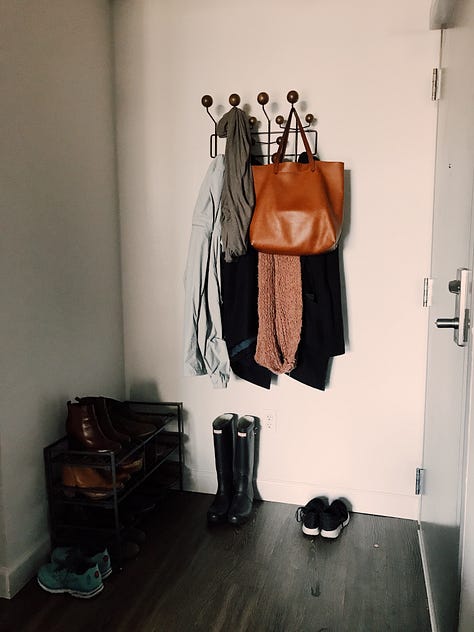
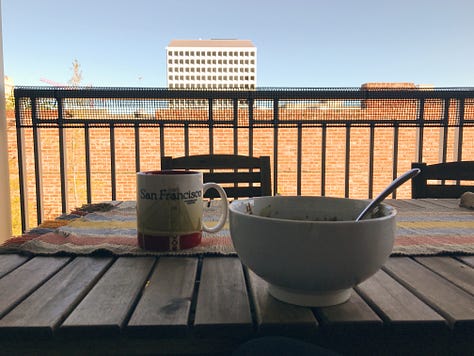
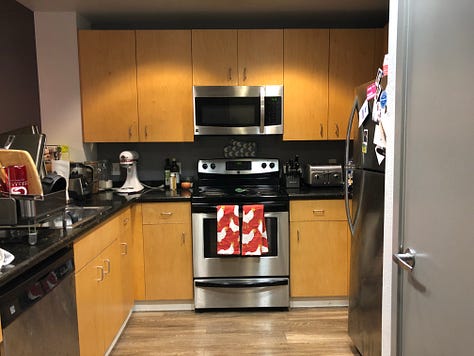
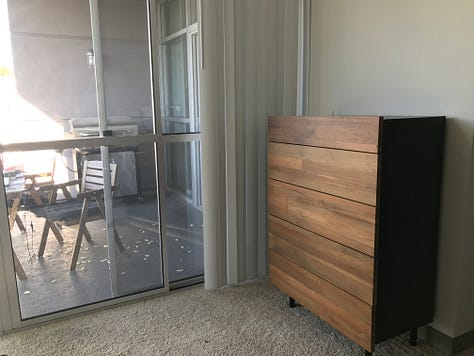
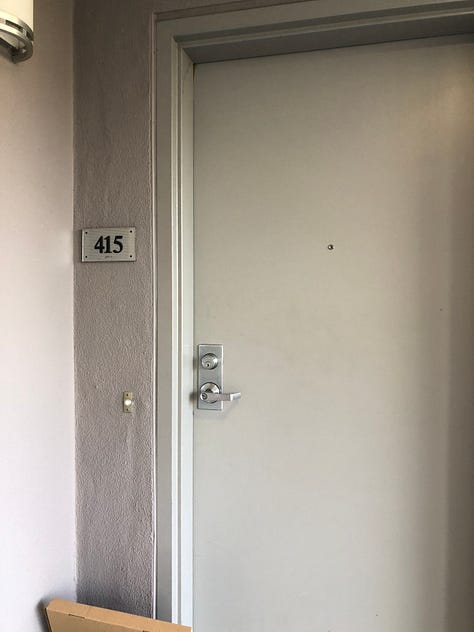
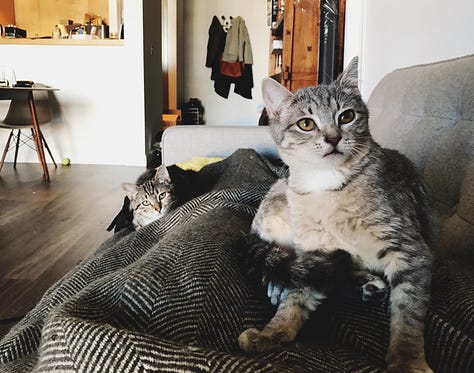
I both acknowledged the lack of character of this apartment and also relished in the luxury of it all (remember, I was 25, from New York City, and used to carry my own laundry to the laundromat across the street in high school).
We dropped our bags off and took a walk to get some coffee at Philz—a coffee shop that even to this day holds a special place in my heart.
As we settled into our new home and found ourselves exploring the area more and more, one thing became very clear to me: I did not like San Jose, or any of the surrounding suburban ‘cities’. I did enjoy the times we would take the train up to San Francisco and always enjoyed exploring that city. It felt a bit closer to New York in terms of access and culture, while maintaining some of the smallness of Baltimore, and felt like it could be a great compromise between those two experiences.
One day, I turned to my then-boyfriend, now-husband and said, “If we’re going to stay here, I need to be in San Francisco”.
It wasn’t all bad, but I just knew there was more life I could be experiencing. We did have some favorite restaurants in our neighborhood and some great friends in the South Bay (some of whom I’m still friends with today). We took up biking as a hobby, which might be funny to those who know us IRL—our bikes have been in a corner of our current living room since we’ve moved back to New York, and I’m too afraid of other cars and not confident enough in my bike skills to ride on the street.
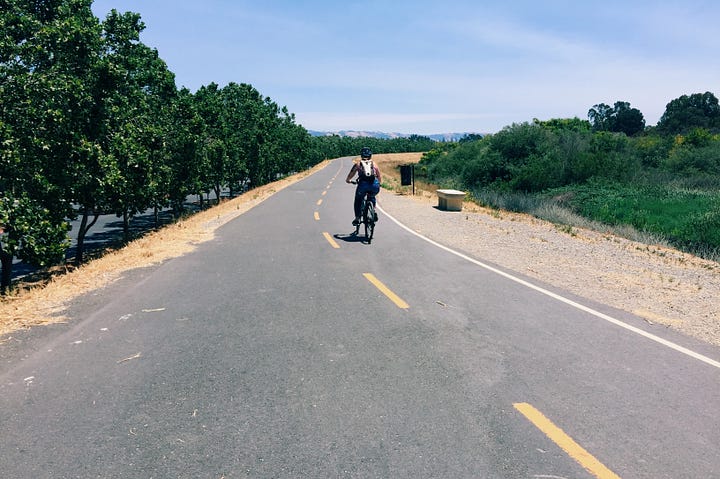

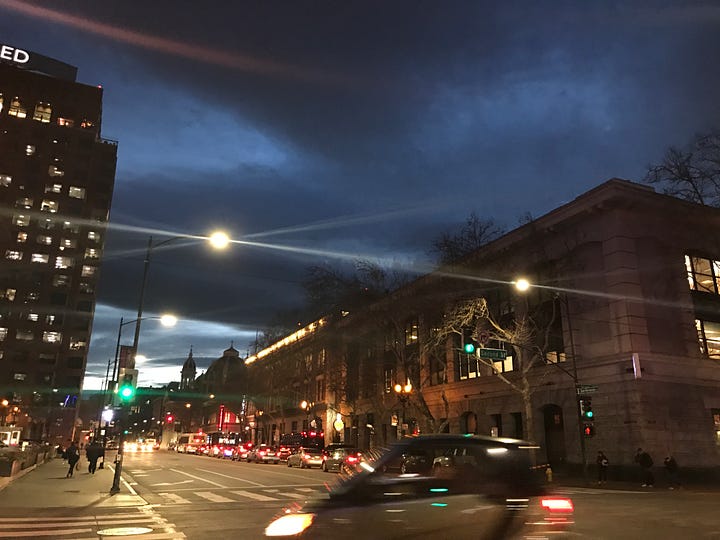
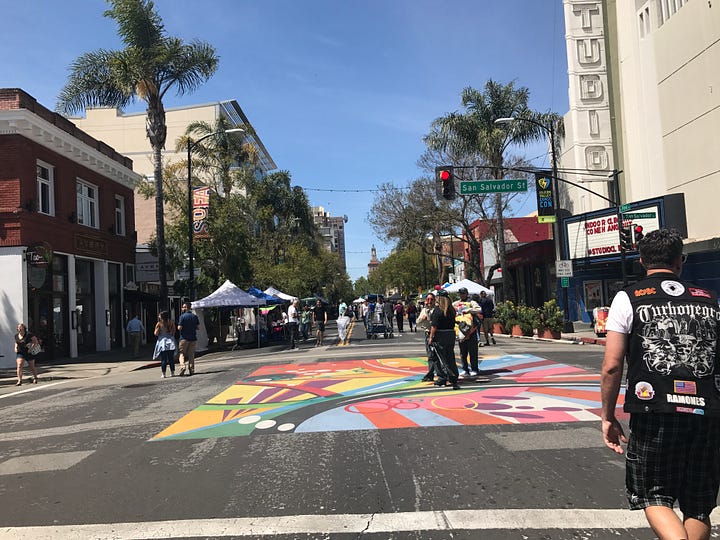
But even so, once I shared my desire to move out loud, I knew I couldn’t bottle it back up. I knew moving to San Francisco would prolong the amount of time I could spend in the Bay—at this point, I didn’t really have an end date in mind, when asked, I would say “I could be here for another few years, maybe even another decade, but I know I can’t die out here”.
So, we began our search. We spent a long time looking at apartments in the area—catching the CalTrain after work and rushing to make open houses, spending weekends exploring neighborhoods, and after a few months, having no luck. The apartments were tiny, the rents were high, and the neighborhoods we could afford were either so far out it didn’t feel like we were even in the city or close but not anywhere I’d want to walk around, alone, at night. We knew that if we were going to make this work we would need to let go of our current luxuries, but I didn’t realize just how much we’d need to let go of until we started our search.
And then, one evening, we found ourselves in the worst apartment I’ve ever loved.
We looked at an apartment in Hayes Valley—a neighborhood that has restaurants, a few bars, and a lot of retail shops. I remember not wanting to go because the price was less than our current place, the neighborhood was one we liked (and one that was actually bustling), and the pictures shown on the craigslist ad I responded to were not plentiful.
There were a lot of real estate scams around this time, and I got used to monitoring the red flags—applications to be filled out (and fees paid) before viewing, addresses that didn’t match the photos, management companies that didn’t seem to exist. This one didn’t have that—just really cheap rent in a really cool neighborhood and a guy named Bob1 that offered to show us the apartment after work one day.
The apartment was in a pink building right off of Patricia’s Green, a lovely patch of grass that took up the space of about two city blocks, and would be the home to some award-winning burning man statue every year. The building had no front door, only a wide gate, but the mailboxes and landing were open air. What is it with this city and their open hallways, I think.
We walk up the stairs—yes, a proper walk-up and no elevator in sight—to the second floor with Bob. He fumbles to find the right key to the orange door of Apartment 6 and we enter through the kitchen, the first of four rooms in this apartment.
The kitchen is about as big as our kitchen in San Jose but about 10% as functional—there’s a fridge in one corner, a tiny countertop and cabinet duo that fit a small sink and a single two-door cabinet in another corner, and an oven haphazardly placed near a window. There were two doorways on the third wall—one, leading to the bathroom, and one that was open, leading through a pretty tiny hallway.
We walked through the bathroom, which again wasn’t tiny but horribly laid out. A mirror that was situated at chest height, so I could view what my outfit looked like between my neck and my knees. A shower that was so tall it was hard to find a shower curtain for but so tiny showering was only really seen as a means to get clean rather than a moment of relaxation or self care. I would shower at the gym or at SoulCycle as much as I could, and my husband jokes that he would be taking a shower and his body would be touching the three shower walls plus the shower curtain.
The bathroom led directly to one room, the smaller of the two rooms left, and through a pocket door, that room led directly to a final room, sun-kissed with a bay window at the very end of it. There was a second front door to the apartment in this room. This is such a great feature of this place, Bob said. You can drop your groceries off in the kitchen but come and go through this room as you please.
I can’t blame him for trying. And that’s exactly what we’d end up doing once we moved in.
These last two rooms—presumably one the bedroom and one the living room—had wooden floors that at one point had been painted gray (without a finish on top, so they were incredibly porous and impossible to clean). They were slanted—to the point that I can say, with confidence, that a marble would absolutely roll from one side of the room to the other at a pretty decent speed.
Hayes Street was alive below the bay window. During this apartment tour, two things were abundantly clear—this apartment was awful, and I wanted it.
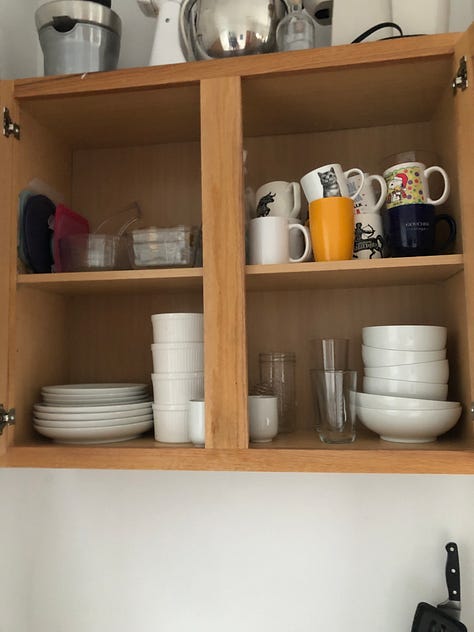
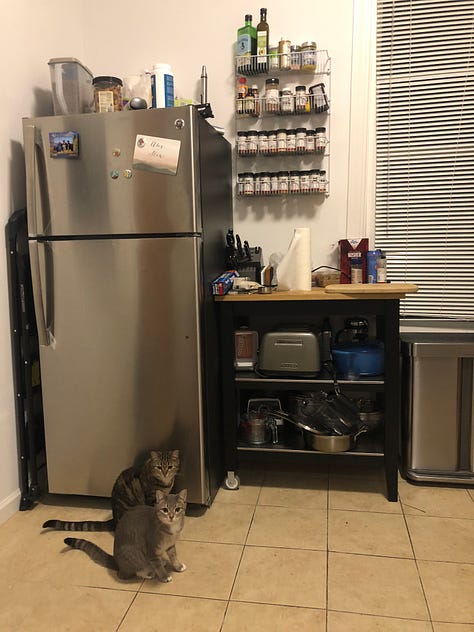
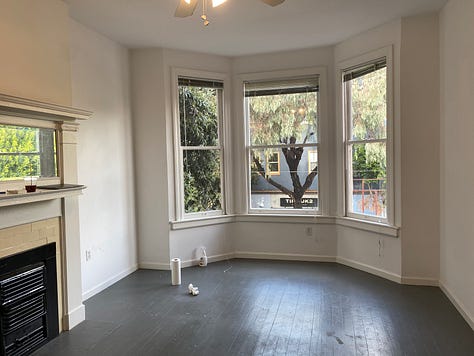
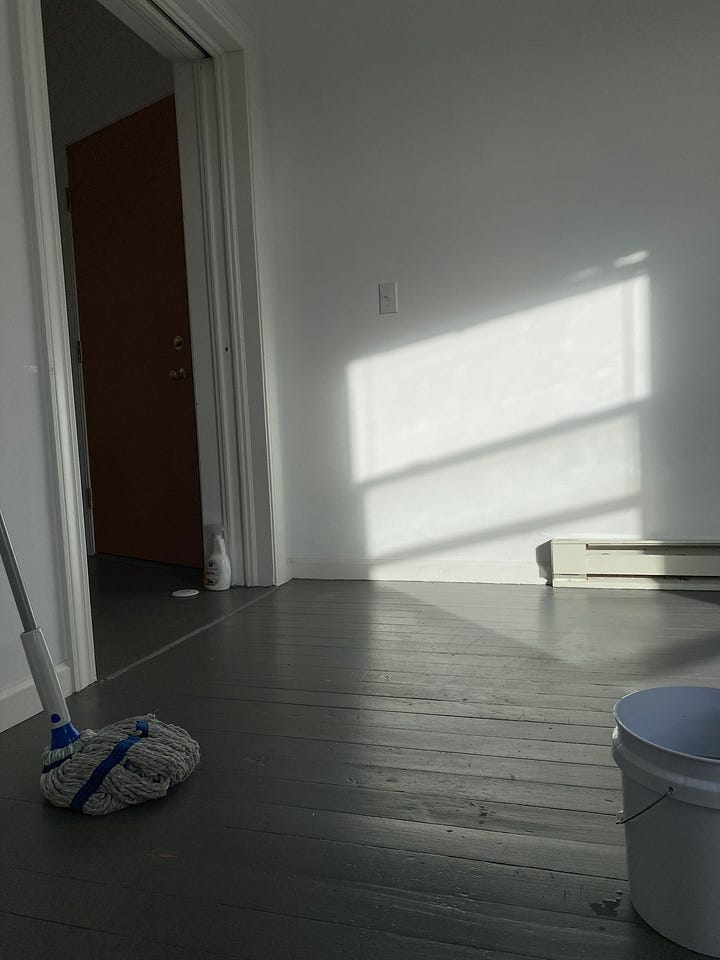

We thanked Bob for his time, told him we’d be in touch, and walked next door to Patxi’s, a deep dish pizza shop Devlin loves and I tolerate.
We discussed the pros and cons over dinner. We’d already discussed our respective commutes being more of a con than anything else—my commute was about an hour on the CalTrain, plus a few stops on the Muni. Devlin worked for a *big tech* company that had a shuttle with snacks and wifi to take him to Cupertino, but it was still a long commute. We talked about the slanted floors and the fact that there was no space for our six-person dining room table (though we kept it anyway and somehow made it work).
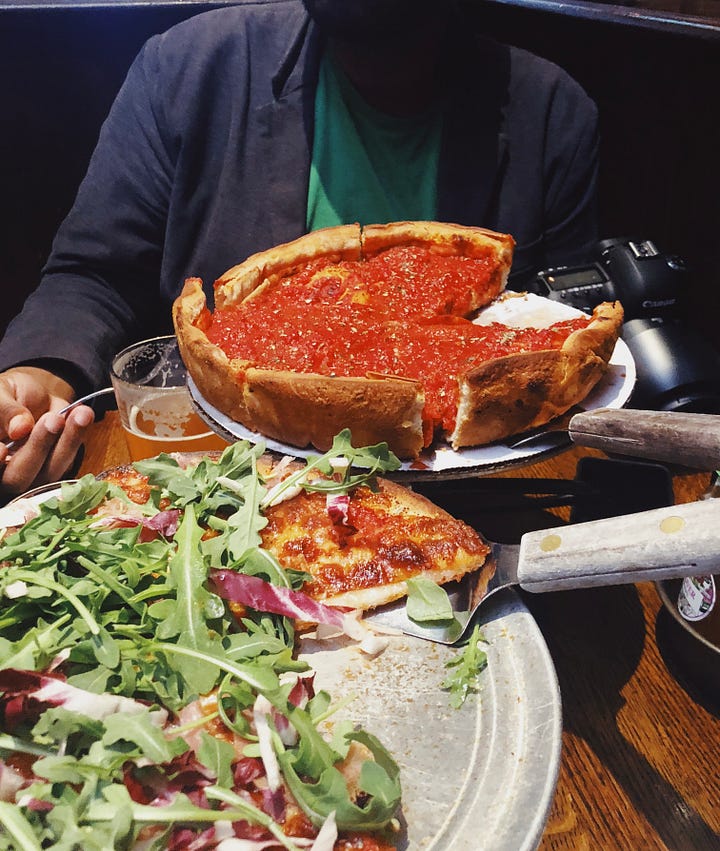
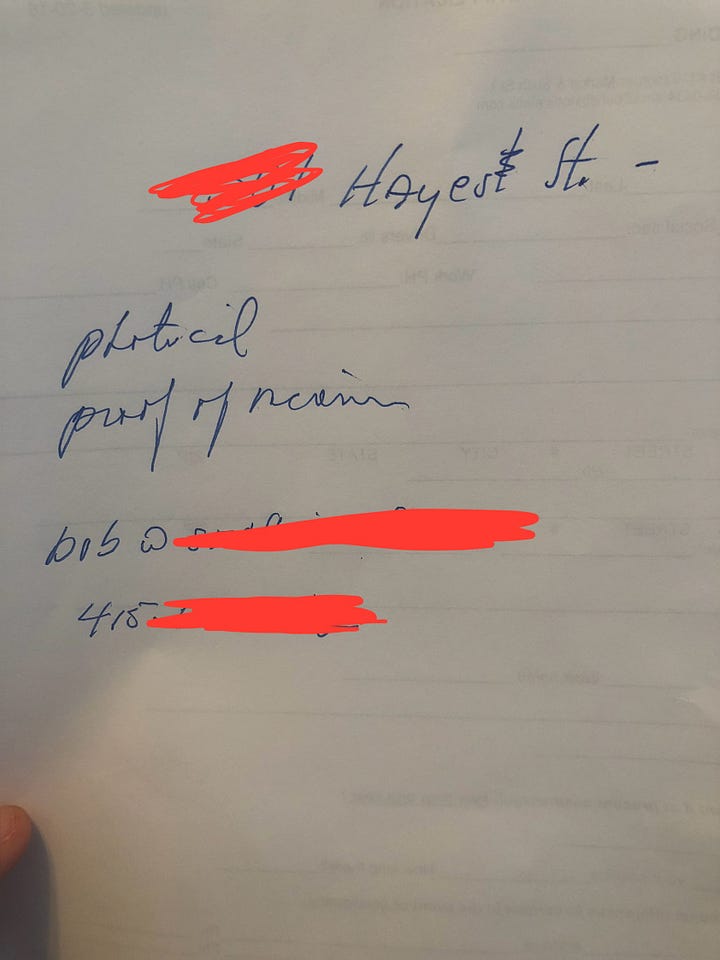
We thought about our current, barren living room and realized that would no longer be the case. We realized there were no closets, and decided then and there we would need to take on a project and turn the one hallway between the kitchen and what we decided would be our bedroom into one—we would just use the bathroom to get between the two rooms.
We loved the neighborhood and despite the fact that the apartment was tiny and weird, I knew I would be happier with life living there than in San Jose.
In many ways that was true—I felt much freer in San Francisco and enjoyed the access to better food and live music. I loved the parks and assumed I’d find “more” of my people but that wasn’t exactly the case.
Oversimplifying a bit, I’d made two distinct groups of friends2 while living in the South Bay: one, a group of friends I’d made at work (many of whom I’m legitimately still friends with, not in a distant parasocial way but talk to almost every day via group chats kind of way) and two, a group of friends I’d made working out that really helped me feel connected. I spent a decent amount of time with those friends, and even after the move I’d find myself trekking down to a city I tried to leave behind more than I’d expected.
I enjoyed my life in San Francisco but it was very much either time with my partner or time solo. I would take myself to workout at classes on my own, discover new coffee shops in the neighborhood, run on Saturday mornings (in my opinion, San Francisco is the only city worth running in, and the only city I consistently ran in). I would see folks when they came up to the city or I’d made the trip down, but as a whole, I feel like I discovered who I was and what I liked without large friend groups.
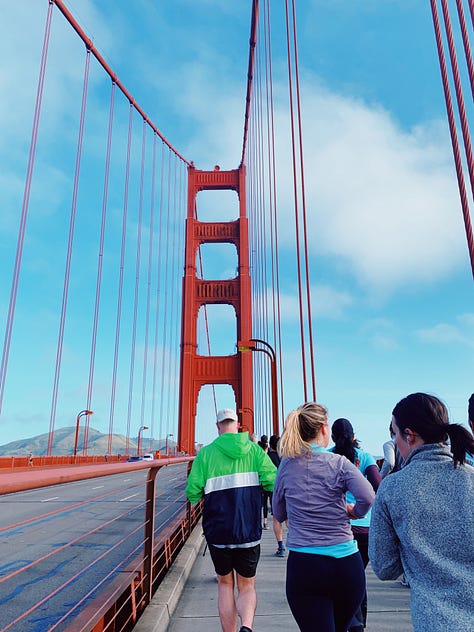
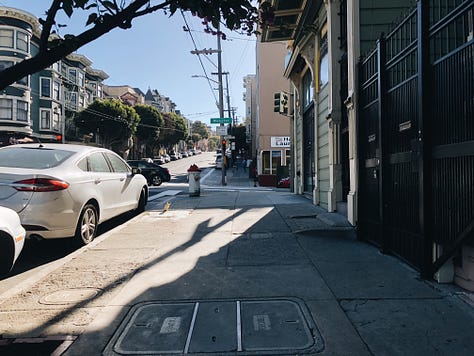
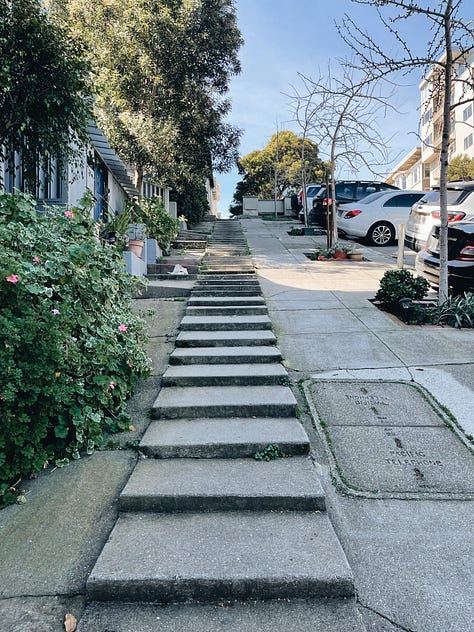
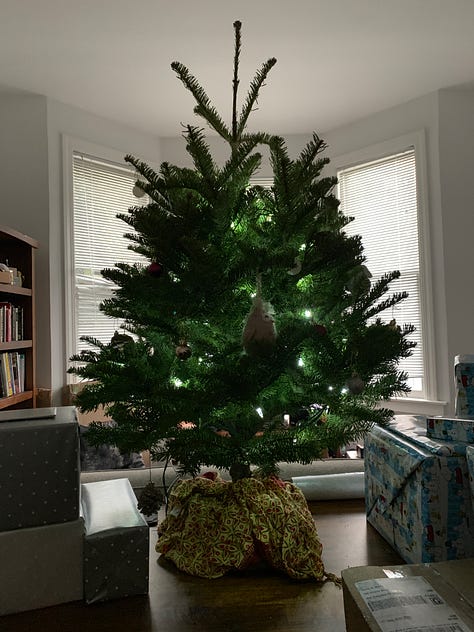
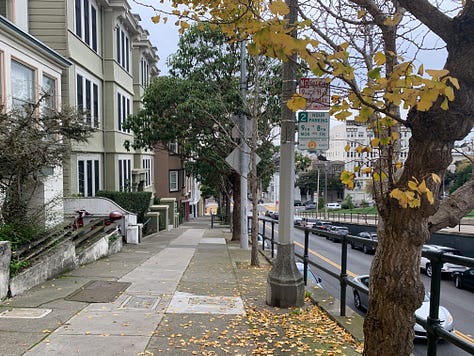
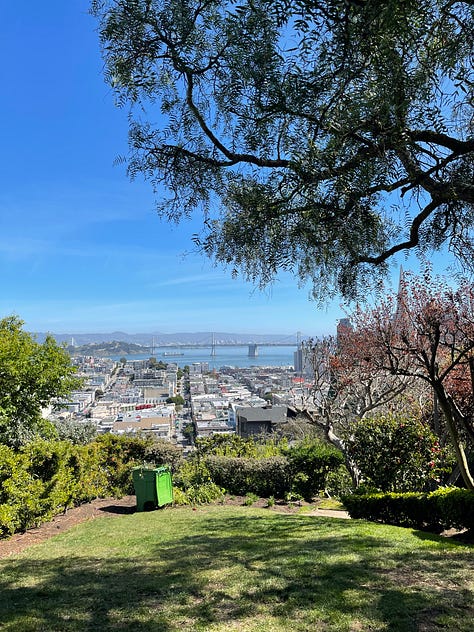
At moments it was lonely, but as a whole it was actually quite freeing and important for me, then in my late-20s. As an only child who grew up in New York City, taking myself to do the things I wanted to do is not foreign to me, but it was the exception, not the rule. Prior to living in SF, I could always find someone to workout with, go out to a meal with, etc. if I wanted to. Allowing myself to enjoy this city I loved on my own was actually a bit special, even if it was sometimes hard.
For the first half of our life in the Bay, I absolutely loathed where we lived but was so grateful for all the people I’d met there. For the second, I didn’t have friends that I saw very often but I had so much more freedom and pleasure because of how much I loved where I was. Both also served as important anchors in my relationship with my now-husband—while my memories are rich with the friend-moments in San Jose and solo moments in San Francisco, us building our lives together was a constant in both places.
There is a best of both worlds, which for me is back on the East Coast, specifically in New York. A city I love and people I care about—as much as I tried, I couldn’t quite replicate that experience in California. I don’t think I was meant to.
We moved back east in 2019 after I got a job that moved us to New York, which was admittedly sooner than I thought we’d leave but in hindsight it was perfect timing3. I look back on those three years fondly, even though I know it wasn’t the city for me in the long term.
So what makes a place livable? Is it the people you meet or a connection to the city? Does one matter more than the other? Is it having ‘your person’ there, as the common thread throughout it all? I don’t think I have answers—rather, I think all of these help, and for me the best case is one where I have as many of these things as possible.
Relationships can be maintained across borders. Without those connections, life can feel a little bit lonely but if I like the place enough to go out and enjoy myself, it feels like less of a blow. Not liking a place is harder to combat—I think of how many good memories I had in San Jose and that was mostly because of the people. My good memories in San Francisco were mostly thanks to the city itself.
I learned a lot about myself out there, and I’ve adopted a few habits—mainly, refusing to call California ‘Cali’ and San Francisco ‘San Fran’. I have a new appreciation for how seasons mark the passing of time but also am much less tolerant of the extremes of both winter and summer.
Loving a place is important to me—I can love a place and enjoy it on my own, but it is also really important to have good people in my corner. And my goodness, I miss the weather.
Name not changed
I could write an entire essay about the people I met in the Bay, but this one is more about a place and all so I’ll leave it loose.
yes, this is in reference to the pandemic. I can’t imagine being quarantined to and working from that tiny apartment




What is it with landlords and black sparkly formica? Does anyone actually choose this look for a place they own?!